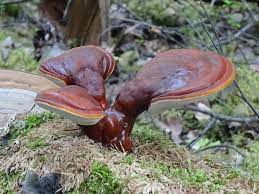Ganoderma Lucidum: Magical Mushroom

Worldwide attempts are being made to popularise Ganoderma lucidum (Magical Mushroom) for business and livelihood, by cultivating it on wood logs and sawdust.
- It is a medicinal mushroom in use for centuries to heal diseases like diabetes, cancer, inflammation, ulcer as well as bacterial and skin infections.
- In India, however, the potential of the fungus is still being explored.
- It is considered one of the most important medicinal mushrooms in the world since its chemical constituents exhibit numerous medicinal properties.
- They have earned it monikers such as “mushroom of immortality”, “celestial herb” and “auspicious herb”.
- It is globally also known as “red reishi mushroom”.
- The history of consumption of this mushroom can be traced back to 5,000 years ago in China.
- It also finds mention in the historical and medical records of countries like Japan, Korea, Malaysia and India.
- Unlike normal mushrooms, the peculiar character of this one is that it grows on wood or wood-based substrate only.
- It thrives well in warm and humid climates, and grows preferably in mixed forests of subtropical to temperate regions.
- It contains more than 400 chemical constituents, including triterpenes, polysaccharides, nucleotides, alkaloids, steroids, amino acids, fatty acids and phenols.
- These show medicinal properties such as immunomodulatory, anti-hepatitis, anti-tumour, antioxidant, antimicrobial, anti- Human Immunodeficiency Virus (HIV), anti- malarial, hypoglycaemic and anti-inflammatory properties.
- Apart from medicines, Ganoderma lucidum is also used as a base material for manufacturing products such as tea, coffee, energy supplements, health boosters, beverages, baked goods and anti-ageing cosmetics.




